Georgina RannardClimate and science correspondent
 Gwyndaf Hughes/BBC
Gwyndaf Hughes/BBCGwyndaf HughesClimate and science videographer
In an ordinary field in a quiet part of east England, a unique experiment is taking root.
“When I tell people what I’m doing here, they think I’m joking,” says Nadine Mitschunas, the UK’s first and only rice-grower.
The crops in four small paddy fields are doing well, helped by basking in our hottest summer on record.
“We could never have contemplated this would grow here,” says farmer Sarah Taylor, whose land the rice is planted on. “Not in a million years,” her husband Craig adds.
This young crop is part of an ambitious trial to see what foods Britain could grow in the future.
The trial is trying to answer big questions about how we can produce enough food and protect farmer’s livelihoods in a world being altered by climate change.
The BBC got a sneak peek at the rice plants before harvest.
Rice plants look a lot like thick grass. But running up the stalks there are small beads – these are the rice grains. They were still brown when we visited, but will be picked when they turn white.
Nadine, an award-winning ecologist, is incredibly proud.
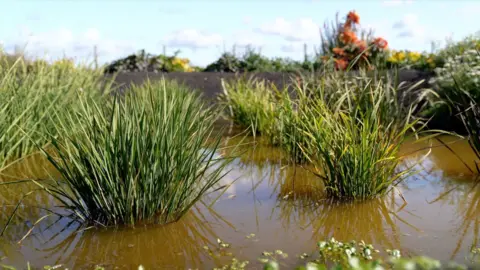 Gwyndaf Hughes/BBC
Gwyndaf Hughes/BBC“I’m actually amazed because they are big, happy, bushy plants,” she says, warning me not to fall over when we step into the calf-deep water.
She points out her favourites. “This is Estrella from Colombia, the best one so far,” she says. “But I’m least impressed with this,” she says, gesturing to a Japanese rice that has not flowered.
This experiment is the brainchild of the UK Centre for Ecology and Hydrology (UKCEH), in partnership with Craig and Sarah Taylor.
Dozens of plants were planted in four mini paddy fields dug out and flooded on the Taylors’ farm a few miles north of Ely in Cambridgeshire.
We often think of rice as a tropical plant, but it does grow in colder climates.
Nine varieties are growing, including from Brazil, Colombia, Italy and the Philippines. They include the stars of the rice world – risotto, basmati and sushi.
The plants did well in the hot, sunny summer, which the Met Office says was the hottest in the UK since records began in 1884.
“Nobody has tried this before, but with climate change, we have crops that, 10 years ago, we wouldn’t have thought would be viable. In 10 years time, rice could be a completely perfect crop for us,” Nadine says.
This is the very edge of where rice can grow at the moment and it would be a risky crop for farmers to plant commercially, says Prof Richard Pywell who is leading the project for UKCEH.
But Britain’s climate is changing quickly. If annual average temperatures warm by between 2 and 4C compared to pre-industrial levels – a scenario that many scientists say is likely – rice could be grown widely in the UK, according to research.
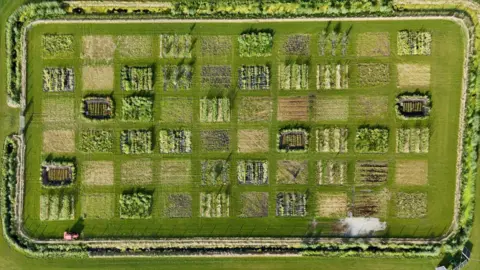 Gwyndaf Hughes/BBC
Gwyndaf Hughes/BBCBut this project is about more than growing British rice for our dinner plates. It could also help the UK tackle climate change.
The land in the Fens is some of the most productive in the UK. A third of the vegetables grown in Britain come from here, with a value of around £1.2bn per year. But this has a significant cost for the environment and climate.
The farms are on rich peat soil that used to be underwater but is now slowly drying out. That is releasing carbon dioxide into the atmosphere, contributing to climate change. Nationally, peat soils account for 3% of our greenhouse gas emissions.
That is also degrading the quality of the soil, a change seen in real time by farmers like Craig and Sarah. They feel deeply connected to the land and its history.
“All my ancestors were Fenmen. I love this place, we’ve been here for 500 plus years,” says Craig.
The rice field is surrounded by potato, onion and beet crops, which are still the thriving staples here.
Digging a healthy clump of potatoes from the rich, black soil, Craig says, “potatoes are an amazing crop. You can’t knock that, but we know things need to change.”
“We don’t want people thinking we’re the ‘crazy rice farmers’ – this is about rethinking the whole system and making it work for everyone,” he says.
Unpredictable weather patterns in recent years have hit farmers nationally, affecting harvests and crop yields in some cases.
“We see that the future isn’t stable. We want to be able to write our own destiny and not have it decided for us,” says Sarah.
“Our legacy for our children and hopefully their children is really important to us and I want them to know that we at least try to make a difference,” she says.
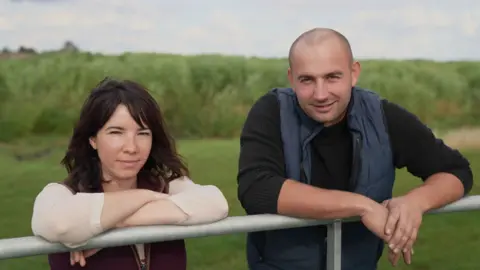 Gwyndaf Hughes/BBC
Gwyndaf Hughes/BBCAs well as rice, the team are trialling other crops including lettuce and hybrid willow that grow in waterlogged conditions.
By flooding the peat soils in parts of Cambridgeshire, greenhouse gases could stay locked in the wet soil, cutting off that source of greenhouse gas emissions.
Even though growing rice produces methane, which is a potent greenhouse gas, initial results from the trials so far suggest the rice crop is not producing more emissions than it helps lock away.
The government is interested in what happens here too, and officials from the Department for Environment Food and Rural Affairs have visited the site.
It could be a radical breakthrough in one of the thorniest questions in the UK – how to protect farming and food supplies, while also addressing the huge impacts they have on the environment and climate.
The UK food system, including imports, is equivalent to 38% of UK greenhouse gas emissions, while agriculture accounts for 11.7%.
Growing rice on peat soils won’t fix that overnight, but it could provide a model.
“We’re at a critical juncture in climate change and we need to make decisions. We need to understand what sort of crops we could be potentially growing in the future,” explains Richard from UKCEH.
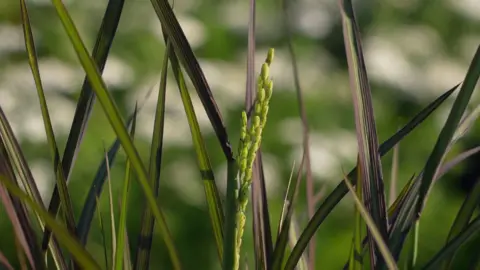 Gwyndaf Hughes/BBC
Gwyndaf Hughes/BBC“It’s possible that for certain areas, peatland re-wetting and growing rice may be a viable option. In other areas, we may continue to grow our conventional crops, but under different conditions,” he says.
Growing rice domestically sounds simple, but this is a complicated project with big ambitions.
It will still be some time before we can test taste a UK rice crop – but it’s a very real possibility that in the next decade, UK-grown rice could be coming to our dinner plates.
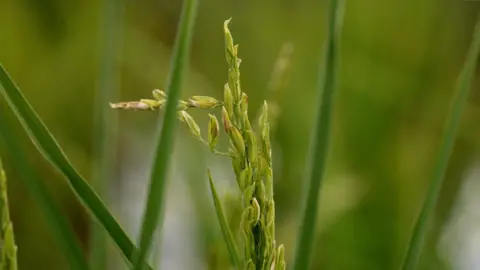 Gwyndaf Hughes/BBC
Gwyndaf Hughes/BBC



